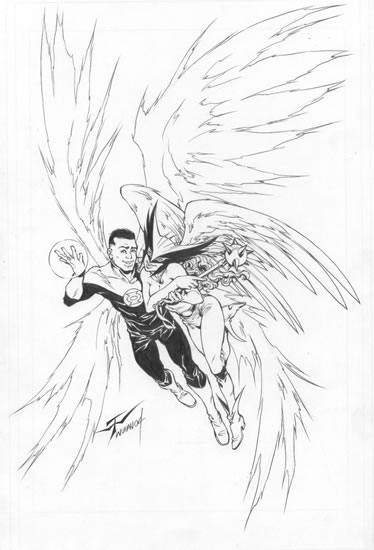Of kids and comics
Kyle Baker's on my mind because of an interview published by Wizard, the fanboy bible, this week, wherein Baker laments the increasing scarcity of all-ages comic book fare:
I think it's shortsighted. I think it's wonderful that there's more variety in books and there are things like Dark Knight. I'm a big fan of Alan Moore and all that stuff, but you really do need to have some stuff for kids. And just from an economic standpoint, at the end of the day, kids spend more money on cartoon products. Spongebob makes so much more money than Superman does. They're really missing the boat. That's my opinion.Ironically, ample evidence exists to demonstrate that all-ages comics and comic-based animation can succeed today, if marketed well. Anyone who's seen any of the various DC Comics animated series produced during the past 15 years, from Batman: The Animated Series to Justice League Unlimited, knows that it's still possible to make superhero action fantasy that's both accessible to kids and relevant to adults.
What's often forgotten about comics is that, until Dr. Frederic Wertham's book Seduction of the Innocent rocked the comics industry in the 1950s, comics weren't thought of as exclusively a medium for children. During the World War II years, comics readership was comprised not only of kids, but also of American military personnel. (Which is why, if you check out comics from the early '40s, you'll discover a level of violence in the books that didn't fully resurface until the late 1980s. In their earliest incarnations, characters such as Batman and the Spectre killed their opponents with alarming frequency.) The EC horror comics of the '50s that Wertham demonized were not intended as children's fare, even though they appeared in the same medium as — and coexisted with — Disney's classic Donald Duck adventures.
Today, the scale has skewed in the opposite direction. Comics are now almost exclusively targeted at an audience of adolescent to young adult males. Most superhero books today aren't appropriate reading for preteens. With the exception of a few survivors like the Archie Comics line, comics for kids are so thoroughly marginalized that they almost don't exist. Which means that, as the comics audience of young men ages, without an influx of new readers, the industry is slowing choking to death.
Okay, not so pretty a picture. So let's look at an artwork that celebrates comics' crossover appeal. It's a fun pinup by artist Wilson "Wunan" Tortosa (Tomb Raider, Battle of the Planets), featuring two of the stars of the animated Justice League series, Green Lantern and Hawkgirl.

The relationship between Green Lantern (real name: John Stewart) and Hawkgirl (real name: Shayera Hol) in Justice League and Justice League Unlimited perfectly illustrates the success the series achieved in melding kid-friendliness and adult sensibility. Not only does the couple share a stormy romance over the course of several seasons, they also deal with a lover's triangle (when Green Lantern becomes involved with another League member, Vixen) and even discover that they have a child together in the future (who grows up to be a superhero named Warhawk).
This, in the context of an animated show kids can enjoy, even if the relationship stuff sails over their heads, much like the Marvel Comics of the 1960s. (Never mind the fact that we see a love affair between a black man and a white woman — okay, Shayera is really an alien who looks like a Caucasian human, but then, so is Superman — and no one even bats an eye.)
Here's hoping that comics publishers figure out that, for their business to survive, they'll have to reach out not only to the fans they already have, but also to the next generation. As for those creators, such as Kyle Baker, who have already tumbled to this essential truth, may their tribe increase.
And that's your Comic Art Friday.
Labels: Comic Art Friday









1 insisted on sticking two cents in:
I agree with you and I think Marvel and DC are slowly catering to such a market. Unfortunately, they're also facing other industries, such as video games and the omnipresent TV and even the Internet, for children's attention. Finally, manga are pulling those few who would be interested in preteen comics away.
Post a Comment
<< Home